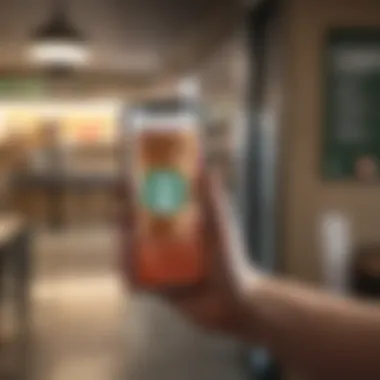Assessing Starbucks Delivery Effectiveness on DoorDash


Intro
As consumer preferences shift towards greater convenience in their daily routines, partnerships between food service brands and delivery platforms have become pivotal. The collaboration between Starbucks and DoorDash aims to address the demands of customers who desire premium coffee and snacks without the necessity of visiting the café. This article will critically evaluate how effective Starbucks is in providing its services via the DoorDash platform. We will analyze key aspects such as order options, delivery efficiency, menu availability, and customer satisfaction. Ultimately, our goal is to synthesize these insights and offer a clear understanding of how well Starbucks meets its customer expectations.
Order Options Available
Starbucks has made significant strides in providing various choices for consumers through DoorDash. Customers can access an extensive menu, including popular coffee selections, pastries, snacks, and seasonal items. However, there may be differences in what is available, depending on local store inventories and participation.
Menu Limitations
While DoorDash delivers many customer favorites, there are limitations to note. For instance, some stores may not offer the full range of options seen in physical locations. Seasonal drinks or special promotions may not be included in deliveries, potentially disappointing those seeking exclusive items.
Delivery Efficiency
DoorDash claims its delivery process to be swift. Typically, customers can expect their deliveries within a time frame of 25 to 40 minutes after placing an order. However, several factors affect this aspect:
- Proximity: Ordering from a nearby Starbucks can significantly reduce wait time.
- Peak Hours: Ordering during busy times may lead to longer delays.
- Delivery Personnel: The efficiency and experience of the Dasher contribute to overall speed.
According to customer feedback, the overall efficiency tends to be satisfactory, although some have noted inconsistencies during peak periods.
Customer Satisfaction
The actual experience of using DoorDash for Starbucks orders can vary widely. Many customers express satisfaction with the ability to enjoy their favorite drinks and snacks at home or the office. Ratings reveal that while there are many positive experiences reported, the possibility of incorrect orders or delays should be noted.
Feedback Compilation
The following points reflect common themes in customer feedback:
- Positive Aspects: High quality of food and beverage, convenience of delivery.
- Challenges: Order accuracy, additional fees for delivery and service, varying delivery times.
Implications for Starbucks
The partnership with DoorDash has broader implications for Starbucks. Having a presence on this platform allows the brand to reach consumers who might not typically visit its locations. This service enhances the company's relevance in a rapidly evolving market where convenience often trumps tradition. Furthermore, the collaboration exposes Starbucks to a demographic interested in delivery services. Evaluating such engagement points offers an understanding of modern consumer behavior.
Finale
In examining the intricacies of the partnership between Starbucks and DoorDash, several critical factors come to light. While the service meets the expectations of many consumers, challenges persist. By understanding order options, delivery efficiency, and customer satisfaction, one can appreciate the complexities that define this relationship. Ultimately, for Starbucks, delivering consistently on DoorDash could strengthen its market position amid growing competition in the food delivery landscape. This thorough assessment provides valuable insights for consumers pondering whether to rely on this specific service.
Preamble to Starbucks and DoorDash
The collaboration between Starbucks and DoorDash illustrates a notable shift in the food and beverage industry. As consumer preferences for convenience continue to evolve, understanding how these two brands navigate this partnership can provide valuable insights. This section aims to lay a foundation for the broader discussions in this article. Details about the individual companies enrich the narrative and foster contextual awareness.
Overview of Starbucks
Starbucks, founded in 1971 in Seattle, has grown into a global icon in the coffee industry. Renowned for its diverse range of coffee beverages and social ambiance, Starbucks has consistently emphasized quality and customer experience. With thousands of locations worldwide, the brand represents not just coffee but also a lifestyle. Furthermore, Starbucks endeavors to innovate and adapt. Options for seasonal drinks, specialty beverages, and sustainable sourcing have made it a popular choice for consumers.
Overview of DoorDash
DoorDash, a prominent player in the food delivery market, launched in 2013. Primarily, it connects customers directly with local businesses. The app allows users to order food from a multitude of restaurants and cafes, enhancing convenience. DoorDash stresses fast delivery and efficient logistics. Its user-friendly interface and extensive coverage have positioned it favorably among competitors. In essence, the collaboration with Starbucks is significant, providing a reciprocal benefit to both entities while responding to a rising consumer demand for on-demand delivery options.
Significance of Delivery Services in the Modern Market
In recent years, delivery services have become a cornerstone of the culinary landscape. Understanding this trend is crucial, especially when analyzing the partnership between Starbucks and DoorDash. These services not only streamline consumer access to dining experiences but also reflect societal changes in consumption preferences.
Rise of Food Delivery Services


Food delivery services have witnessed exponential growth over the last decade. The emergence of platforms like DoorDash, UberEats, and Grubhub reshaped how consumers engage with food. Important factors contributing to this trend include:
- Technology Advancements: Smartphone apps and GPS technology have transformed the convenience of ordering food. Customers can now order their favorite items with just a few taps.
- Market Expansion: These services have expanded the reach for businesses, enabling restaurants and cafés to serve beyond their geographical limitations.
- Increase in Availability: Many eateries, from high-end restaurants to casual cafés, have turned to delivery services, aiming to meet growing demands. Perspectives on dining have evolved into a lifestyle wherein food is often enjoying at home or the workplace instead of in traditional casual settings
The culmination of these factors illustrates a definitive movement towards a more service-centric approach to dining, where convenience has become paramount. Based on recent trends, more consumers are integrating food delivery into their daily lives.
Consumer Demand for Convenience
The demand for convenience continues to drive purchase decisions in the modern market. This has resulted in notable changes in consumer habits:
- Time-Pressed Lifestyles: With increased work demands, many individuals struggle to find time to cook or go out. Delivery services offer a practical solution.
- Diverse Options: Consumers seek diverse meal choices without the obligation of dining out. Services from DoorDash provide an array of selections from multiple venues in one order, granting a variety rarely achieved previously.
- Rewarding Experience: Utilizing food delivery often generates a sense of indulgence, making it a popular option for special occasions.
In sum, as consumer preferences continue to shift towards convenience, the importance of delivery services becomes ever more pronounced. The Starbucks and DoorDash partnership can therefore be seen not just as an operational improvement, but also as a strategic alignment with consumers' evolving needs.
Starbucks’ Decision to Partner with DoorDash
The partnership between Starbucks and DoorDash is pivotal in the evolving landscape of food delivery services. The significance of this collaboration lies not only in enhancing the coffee giant's outreach but also in meeting growing consumer expectations for convenience in the market.
Strategic Rationale Behind the Collaboration
Starbucks took a deliberate step to partner with DoorDash based on several strategic factors. First, market trends indicate a substantial increase in food delivery, especially post-pandemic. With more consumers turning to technology for ordering food and beverages, teaming up with a delivery service like DoorDash allows Starbucks to tap into a larger customer base efficiently.
Moreover, this partnership facilitates offering an extensive menu to consumers without necessitating the infrastructural changes that physical store expansion would require. By leveraging DoorDash, Starbucks can provide quicker service and introduce local menu items. This flexibility can enhance customer loyalty and engagement without additional logistical burdens.
Additionally, the partnership allows for real-time data sharing and analytics, providing valuable insights into customer preferences and habits. Knowing what customers order most frequently can help Starbucks tailor offerings that suit various demographics, ensuring a profitable alignment with consumer trends.
Expected Outcomes for Both Brands
The consequences of this partnership appear promising for both Starbucks and DoorDash. For Starbucks, entering the delivery market through DoorDash means potential revenue increase. The access to DoorDash’s vast infrastructure and customer base can result in higher foot traffic. Customers who might not visit a store due to convenience can now order coffee effortlessly from their phones.
From DoorDash's perspective, intertwined success is also on the horizon. Featuring such a prestigious brand broadens their appeal, attracting a larger audience. Increased orders directly translate to finanical gain.
- The partnership enables both brands to pursue their strategic goals: one focusing on enhancing customer convenience, while the other zeros in on growing their market presence.
Both companies can also expect cross-promotional opportunities. For example, seasonal Starbucks promotions might draw in customers who initially came for DoorDash's services.
In summary, the decision for Starbucks to affiliate with DoorDash illuminates a broader strategy grounded on benefits associated with technology adoption, market demands, and shared growth potential.
How Does the Delivery Process Work?
Understanding the delivery process is crucial for gauging the effectiveness of Starbucks’ service via DoorDash. As consumer preferences shift toward the convenience of online ordering, the efficacy of this process becomes more significant. It factors into how easily customers can place orders, how quickly deliveries are executed, and the satisfaction derived from these interactions.
Placing an Order on DoorDash
Step-by-Step Order Placement
In the increasingly busy world we live in, the method, by which one can place an order for Starbucks through DoorDash, is essential knowledge. The interfaces of both the DoorDash app and the website allow users to navigate through menu items with ease. This streamlining is a key characteristic, as simplicity directly enhances user experience. Users start by entering their address, which prompts suggestions from nearby Starbucks locations.
Once the desired location is selected, users can browse through the Starbucks menu, adding preferred items to their cart. The step-by-step ordering process ends with an option to review the entire order, ensuring nothing is missed. This approach is lauded for its r Дмит렇게աքանչյուր적руст vobnimbe na дажепыт daywes efficiency, while also minimizing confusion.
Payment Options
The payment options available during the order placement process also hold notable importance. Offering various payment methods, including credit and debit cards as well as popular digital wallets, increases accessibility for many users. Such flexibility stands out as a beneficial feature, as it aligns with diverse consumer preferences and habits in the current market.


Each payment method may come with its unique advantages. For instance, using a digital wallet can expedite the checkout process. However, it is crucial to be aware of potential transaction fees that some payment providers may charge, impacting the final cost.
Ordering from Starbucks Menu
Menu Items Available
Grasping what menu items Starbucks offers through DoorDash is imperative. Customers expect availability of popular beverages, such as lattes and seasonal favorites. A comprehensive menu listing all items aids in decision-making, representing a significant factor in customer choice.
The exclusivity of some regional items or seasonal drinks available on the DoorDash app enhances its appeal. However, frustrations can arise due to unavailability of certain items at specific locations. Thus, while variety can be a strong selling point, it requires regular updates to information to alleviate disappointments.
Special Offers and Promotions
Special offers and promotions are another compelling reason for consumers to utilize DoorDash for Starbucks orders. Regular promotional deals not only attract new customers but also encourage loyalty among existing one's. These offers are often highlighted within the app. As these limited-time deals entice users, they represent a strategic method of boosting sales in a competitive market. However, the catch is needing to promote these offers dynamically to ensure users notice them, which can sometimes be neglected.
Delivery Efficiency and Timeliness
Understanding the delivery efficiency and timeliness of Starbucks' offerings through DoorDash is essential. These factors significantly influence customer satisfaction. Customers expect affidale delivery times. Thus, both Starbucks and DoorDash must maintain certain standards. The relationship between these components impacts consumer loyalty and repeat orders.
Delivery Times Compared to Industry Standards
Delivery times play a crucial role in the food and beverage industry. In general, customers anticipate meals within 30 minutes of placing an order. Reports indicate that DoorDash can typically meet these expectations when delivering Starbucks' products. However, fluctuations can occur due to various factors like location and order volume. For those waiting myseriously longer, disappointment arises. Customers compare the experience to industry averages. An efficient delivery system must enhance the experience rather than diminish it.
Key Points:
- DoorDash aims to achieve competitive delivery times.
- A 30-minute delivery window often aligns with consumer expectations.
- Long wait times can negatively impact Starbucks' reputation.
Factors Affecting Delivery Efficiency
Several elements can influence how quickly orders can arrive at a customer’s door. Even with an established partnership, both Starbucks and DoorDash face challenges. Not all areas deliver with the same effectiveness.
Key Influences:
- Geographical Location: Urban areas often have better delivery efficiency than rural locales. However, restrictions or traffic can complicate matters.
- Order Volume: During peak hours, the volume of orders affects speed. High demand can lead to longer waits.
- Store Readiness: If Starbucks is prepared with orders before a driver arrives, delivery time decreases dramatically.
Addressing these issues can significantly improve the level of efficacy felt by the consumer.
It’s critical for both companies to monitor these patterns continually. Attention to these factors will contribute to better service over time. The overall link between efficiency and retention underscores the importance of this aspect of the partnership. Overall, not only do timely deliveries delight customers, but they also cement their loyalty to the Starbucks brand.
Customer Satisfaction and Feedback
Customer satisfaction lays a solid foundation upon which businesses like Starbucks measure success, especially as they expand their services through platforms like DoorDash. Understanding how well customers receive their orders and overall service is critical for both brands. The emphasis on customer satisfaction inside this article focuses on different factors affecting consumer experiences in the delivery process, including quality, clarity of the order system, and timeliness of delivery.
This section examines specific elements that contribute to customer satisfaction. An important benefit is how positive feedback can enhance the brand reputation. Moreover, dissatisfied customers can lead to detrimental word-of-mouth situations. Addressing these concerns not only improves service quality but also fine-tunes the partnership between Starbucks and DoorDash. Feedback pens a vital communication line between inverse customers and producers, resulting in privation for alterations that can demystify the user experience.
Analyzing Customer Reviews
Customer reviews serve as a crucial tool in evaluating the effectiveness of Starbucks' offering via DoorDash. As customers recount their experiences, a pattern often emerges highlighting common grievances and commendation. Customers usually express their opinions through these avenues:
- Speed of Delivery: Many reviews capture whether their orders arrive promptly or if there is a delay.
- Quality of Products: The freshness and accuracy of items delivered weigh heavily in consumer satisfaction.
- Service Experience: The demeanor and professionalism of DoorDash drivers can shape the delivery experience.
In a matter of continued observation, most consumers applaud Starbucks for accuracy in fulfilling coffee orders. They appreciate the ease of using the DoorDash app, allowing users to navigate the menu seamlessly. However, some clients report contrariety concerning timely deliveries during peak hours.
Common Issues and Complaints
While many customers find satisfaction in Starbucks’ service through DoorDash, certains issues persist. Addressing these complaints is essential for maintaining a positive relationship with the customer base. Common complaints that arise include:


- Order Inaccuracies: A frequent complaint is that items sometimes arrive wrong or missing altogether.
- Delayed Deliveries: Especially during busy rush hours, delays become a noteworthy factor in dissatisfied reviews.
- Temperature of Food and Beverages: Some customers report that drinks can arrive cold or hot incorrectly, impacting the overall experience.
It's crucial for both Starbucks and DoorDash to recognize and rectify these common pitfalls. Regular digestive not crops up as they can negatively impact overall consumer perceptions, resulting often in declining engagement from habitual customers. Monitoring customer feedback actively can help troubleshoot issues before they escalate into broader reputational woes.
Comparative Analysis of Delivery Services
The partnership between Starbucks and DoorDash allows for an interesting comparison with other delivery services. Analyzing how they operate gives valuable insight into factors surrounding food and beverage delivery. Each service has unique strategies, strengths, and weaknesses, which inform the choice of consumers. Understanding these differences can help in evaluating whether Starbucks truly delivers value via DoorDash or aligns itself more beneficially with customer expectations.
Starbucks vs.
Other Coffee Chains
Starbucks stands as a prominent player in the coffee industry, known for its premium coffee and customer-centric approach. However, the competitive landscape includes several other coffee chains that also focus on delivery solutions. Understanding how Starbucks holds up against rivals like Dunkin', Peet's Coffee, and Tim Hortons is crucial.
- Delivery Range: While all chains have sought partnerships with delivery platforms, the extent of delivery coverage differs. Starbucks, leveraging DoorDash, reaches a broad audience, but competitors also use multi-partner strategies which can yield varying results for customer access.
- Menu Options: Starbucks offers diverse menu items, from espresso beverages to baked goods. Contrast this with Dunkin’, which also has strong offerings but a distinct focus on donuts and breakfast sandwiches. The broader Starbucks menu can be more appealing for those haunting a mid-afternoon pick-me-up.
- Pricing & Promotions: Starbucks may command higher prices reflecting its brand status. Yet, it occasionally runs promotions to mitigate this, making comparison essential. Competitors often provide substantial discounts and loyalty rewards that may attract price-sensitive consumers.
DoorDash versus Competitors
When evaluating Starbucks' delivery service, it is vital to consider the performance of DoorDash vs. other delivery apps like Uber Eats and Grubhub. Their operational efficiencies and features can significantly affect customer satisfaction.
- Delivery Efficiency: DoorDash often touts quicker deliveries, using a distinctive algorithm to optimize routes. In comparison, Uber Eats maintains a robust network cross-functional drivers that adapts swiftly to food demand changes. Each service's operations directly benefits or detracts from Starbucks delivery performance.
- Customer Reach: DoorDash reportedly accesses a vast audience, paralleling competitive platforms. The differentiation comes down to user experience within the app. For instance, DoorDash promotes a seamless order interface, which is critical for maintaining wine buyers’ interest. Competitors may not always provide the same maturity in user-experience.
- Customer Support: Customer service can heavily influence perceptions of reliability. DoorDash has invested in support but can differ substantially. For example, if users experience issues while ordering Starbucks, their experiences will vary by service. Therefore, understanding which service provides better post-order support can inform decisions for target customers.
In summary, delivery services' comparative analysis is not just about availability; it involves deeply understanding menu choices, pricing strategies, and operational efficiencies that serve to differentiate them in a crowded market.
Future Implications for Starbucks and DoorDash
The partnership between Starbucks and DoorDash represents more than a mere business arrangement. This section analyzes future implications of this collaboration, and it highlights how evolving consumer needs and market dynamics will shape both brands. With the rise of online shopping and food deliveries, the effectiveness of this alliance might define their respective trajectories in an increasingly competitive market.
Long-Term Prospects of the Partnership
Starbucks and DoorDash now form a meaningful alliance. This longer-term perspective is essential. As consumer preferences change, such partnerships often converge. The availability of familiar beverages at doorstep steps may encourage consumers to opt for delivery instead of visiting a physical store. Some specific potential outcomes are:
- Increased Customer Retention: Customers bored with their choices at physical locations may engage more when ordering from DoorDash, discovering tailored experiences.
- Broader Audience Reach: DoorDash offers a gateway to reach consumers who wouldn’t typically breeze past a Starbucks café. This digital connection broadens Starbucks' reach.
- Revenue Growth: Delivery orders could supplement transactions which were, before this partnership, confined to in-store sales. Every minute saved amplifies both brands’ commercial viability.
However, they must address certain challenges. Updating logistics for expansion and ensuring quality in orders delivered is critical. Meeting shifting expectations cannot be dismissed. The brands may need additional strategic adjustments in terms of menu items or even delivery zones.
Impact on Consumer Behavior
Connecting with consumers signifies the need for understanding behavioral ramifications this partnership triggers. With convenience valued more than ever, demand for food delivery will likely remain a stable choice moving forward. Some implications are worth noting:
- Increased Reliance on Delivery Services: Customers adapt to quick service. Many may develop a habitual tendency to order from Starbucks through DoorDash, edging out cravings having to conveniently shop around.
- Expectations of Instant Gratification: Tied into the culture of immediacy, consumers may come to expect that culinary delights arrive at their resonated location faster. Therefore, consistent quality becomes paramount.
- Influence on Menu Choices: Preferences might radically change. Insights from customer order data can shape offerings over time, steering pressure to streamline choices for delivery. This intention fills consumer satisfaction with agility.
- Cultural Shifts Around Food Consumption: With many options available at customers' fingertips, eating patterns could change. As purchases become expedient, minds attuned to what today feels can redefine ‘going out for coffee’ to ‘ordering coffee in (while remaining at home)'.
Analyzing these effects provides crucial foresight. As both Starbucks and DoorDash navigate the intricacies of consumer behavior shifts, ensuring alignment between service improvements and customer expectations will likely enhance their long-term goals.
The End
The conclusion holds significant importance in framing the overall narrative of this article. It synthesizes the myriad elements discussed, offering readers a clear perspective on whether Starbucks meets consumer expectations via DoorDash. Understanding the delivery dynamics between these two entities is crucial for various stakeholders.
Through the exploration of logistical aspects, it becomes clear that the efficiency and reliability in delivery can greatly influence customer experiences. Customers, accustomed to seamless convenience, weigh options when choosing their beverage providers. This makes it essential for Starbucks to address any anomalies in their order fulfillment process.
The satisfaction derived from taking coffee directly from local baristas might be complex. Yet, when discussing delivery via DoorDash, an enjoyable experience increasingly becomes a product of timely service and the freshness of items.
Moreover, considering the competitive landscape, Starbucks' collaboration with DoorDash sets a benchmark rivaling other firms in the coffee market. Ultimately, the ramifications of their partnership could reshape how consumers perceive convenience in the food and beverage industry.
Key takeaways regarding the partnership include:
- Timeliness and execution in delivery directly affect consumer behavior.
- Customer feedback is essential in honing service quality.
- The evolving market demands that major brands continually innovate features.
In closing, examining how Starbucks delivers through DoorDash goes beyond mere transactions; it encapsulates a broader trend in dining preferences, where accessibility, promptness, and satisfaction play vital roles. This partnership, therefore, being pivotal, directs additional gateways unveiling changes in purchasing behavior and future development strategies for both brands.
As users increasingly value convenience in daily routines, registrations on digital platforms become a pathway for food culture evolvement.
Future research and consumer insights will provide valuable foresight into the trajectory of both Starbucks and DoorDash, shaping expectations and enticing a larger audience interested in exquisite coffee experiences delivered with efficiency.







